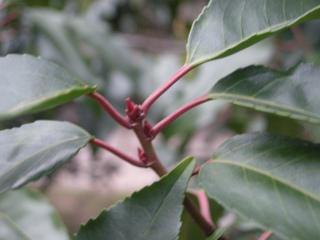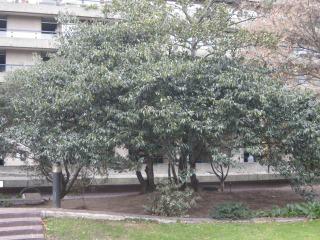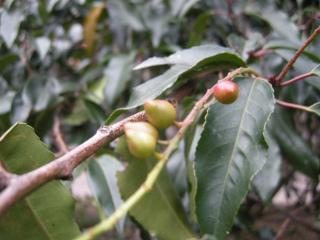
Prunus lusitanica detail (04/12/2011, London)
Position: Full sun to dappled shade
Flowering period: Late spring
Soil: Moist, well drained
Eventual Height: 20m
Eventual Spread: 15m
Hardiness: 6a – 9b
Family: Rosaceae
Prunus lusitanica is an evergreen, spreading large shrub or small tree . The glossy dark green leaves are alternate, oval, have dentate margins and are up to 12cm long and 5cm wide. The leaves are slightly lighter in color below. The mature bark is black/ brown and the young stems are a distinctive red/ purple. The white,scented, spring flowers are hermaphrodite, up to 15mm in diameter and are produced on erect racemes which are up to 25cm long. The fruit are a drupe and are up to 15mm in diameter. The appear green and turn dark purple/ black in autumn.

Prunus lusitanica, commonly known as Portuguese laurel or Portugal laurel, is native to south west Europe. This shrub is now relatively rare in the wild. It was first scientifically described by Linnaeus in Species Plantarum in 1753. It was introduced into Britain from Madeira via Portugal in 1648. All parts of this plant are slightly toxic.
The etymological root of the binomial name Prunus is derived from the classical Latin name for the plum tree. Lusitanica is derived from the Latin meaning ‘of Portugal’.

Prunus lusitanica berry (04/12/2011, London)
The landscape architect may find Prunus lusitanica. as an interesting hedging (or topiary) species with its glossy leaves and red stems. They also make an attractive, exotic looking tree. It is moderately drought tolerant once established.
Ecologically P. lusitanica is attractive to birds for its fruit. The flowers are attractive to bees and butterflies.
The Royal Horticuktural Society has given P. lusitanica their prestigious Award of Garden Merit in 1993.
P. lusitanica prefers moist, fertile, well-drained soils. It is tolerant of most pH of soil, including chalk.
This plant requires little maintenance. If maintained as a hedge, clip in June.

